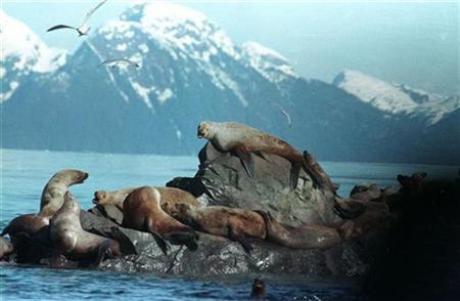Date: 18-Jan-10
Country: US
Author: JoAnne Allen
Beaches Trapping Some Oil From Exxon Valdez Spill Photo: Mike Blake

Sea lions rest on a rock in the oily waters of Prine
William Sound near Knight Island, April 2, 1989, after the worst oil
spill in U.S. history, caused by the Exxon Valdez.
Photo: Mike Blake
WASHINGTON - A lack of oxygen and nutrients below the surface of beaches
in Alaska's Prince William Sound is slowing the dissipation of oil
remaining from the 1989 Exxon Valdez spill, U.S. researchers said on
Sunday.
The team conducted field studies over the past three summers using
geologic information and hydraulics to try to determine why patches of
oil linger on the beaches 20 years after the worst oil spill in U.S.
history.
The supertanker Exxon Valdez spilled more than 11 million gallons (50
million liters) of crude oil, blackening some 1,300 miles of Alaska's
coastline. An estimated 20,000 gallons (90,920 liters) remain, the
researchers said.
They found that the oil remaining was trapped between two layers of
beach and sheltered from the elements, according to the study posted on
the journal Nature Geoscience's website (www.nature.com/ngeo/index.html)
"The oil that is in the upper layer either gets flushed out or
biodegraded. In the lower layer, we found out there's not enough fresh
water exchange to cause any flushing," co-author Michel Boufadel of
Temple University said in a telephone interview.
Boufadel also said oxygen levels in the lower layer were not high enough
for the oil to disappear through natural biodegradation.
"Microorganisms that are indigenous in beaches are capable of breaking
down the oil, of eating the oil, provided that they have oxygen to
breathe and nutrients such as nitrate and phosphate," Boufadel said.
He said earlier research uncovered nutrient deficiency in the area. But
his team was the first to detect the low oxygen levels and the two-layer
beaches.
In the first five years after the accident, the oil was vanishing at a
rate of 70 percent a year and calculations showed it would be gone
within a few years, the researchers said.
About eight years ago, the disappearance rate slowed to 4 percent a
year.
Boufadel's team is exploring ways to deliver oxygen and nutrients to the
lower layer of beach in an effort to spur biodegrading of the remaining
oil.
The study was funded by the Exxon Valdez Oil Spill Trustee Council,
established in 1991 when Exxon settled civil and criminal charges filed
by the Alaska and the U.S. governments.
The council has administered the $900 million that Exxon paid to settle
the state and federal civil cases from the disaster.
(Editing by Eric Beech)
© Thomson Reuters 2009 All rights reserved
